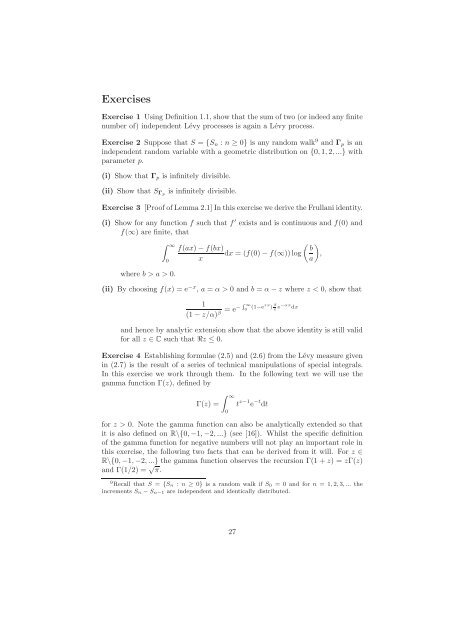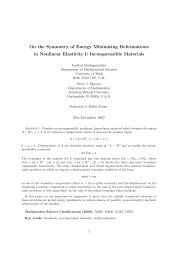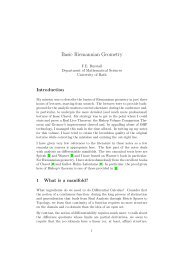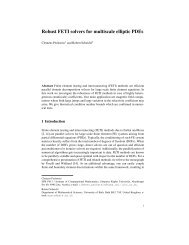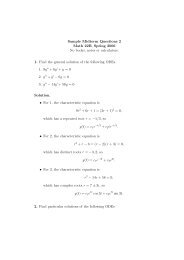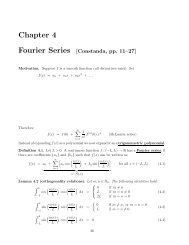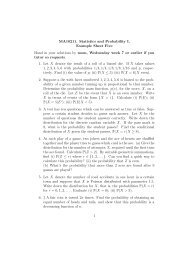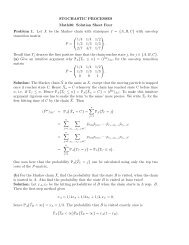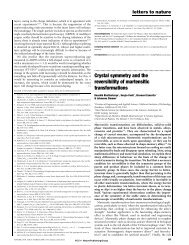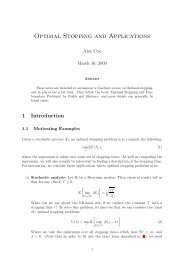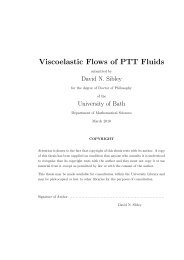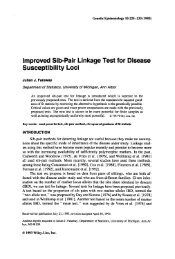1 Lévy Processes and Infinite Divisibility - Department of ...
1 Lévy Processes and Infinite Divisibility - Department of ...
1 Lévy Processes and Infinite Divisibility - Department of ...
You also want an ePaper? Increase the reach of your titles
YUMPU automatically turns print PDFs into web optimized ePapers that Google loves.
ExercisesExercise 1 Using Definition 1.1, show that the sum <strong>of</strong>two (orindeed any finitenumber <strong>of</strong>) independent <strong>Lévy</strong> processes is again a <strong>Lévy</strong> process.Exercise 2 Suppose that S = {S n : n ≥ 0} is any r<strong>and</strong>om walk 9 <strong>and</strong> Γ p is anindependent r<strong>and</strong>om variable with a geometric distribution on {0,1,2,...} withparameter p.(i) Show that Γ p is infinitely divisible.(ii) Show that S Γp is infinitely divisible.Exercise 3 [Pro<strong>of</strong><strong>of</strong>Lemma2.1]InthisexercisewederivetheFrullaniidentity.(i) Show for any function f such that f ′ exists <strong>and</strong> is continuous <strong>and</strong> f(0) <strong>and</strong>f(∞) are finite, that∫ ∞(f(ax)−f(bx)bdx = (f(0)−f(∞))log ,xa)0where b > a > 0.(ii) By choosing f(x) = e −x , a = α > 0 <strong>and</strong> b = α−z where z < 0, show that1(1−z/α) β = e−∫ ∞0 (1−ezx ) β x e−αx dx<strong>and</strong> hence by analytic extension show that the above identity is still validfor all z ∈ C such that Rz ≤ 0.Exercise 4 Establishing formulae (2.5) <strong>and</strong> (2.6) from the <strong>Lévy</strong> measure givenin (2.7) is the result <strong>of</strong> a series <strong>of</strong> technical manipulations <strong>of</strong> special integrals.In this exercise we work through them. In the following text we will use thegamma function Γ(z), defined byΓ(z) =∫ ∞0t z−1 e −t dtfor z > 0. Note the gamma function can also be analytically extended so thatit is also defined on R\{0,−1,−2,...} (see [16]). Whilst the specific definition<strong>of</strong> the gamma function for negative numbers will not play an important role inthis exercise, the following two facts that can be derived from it will. For z ∈R\{0,−1,−2,...} the gamma function observes the recursion Γ(1+z) = zΓ(z)<strong>and</strong> Γ(1/2) = √ π.9 Recall that S = {S n : n ≥ 0} is a r<strong>and</strong>om walk if S 0 = 0 <strong>and</strong> for n = 1,2,3,... theincrements S n −S n−1 are independent <strong>and</strong> identically distributed.27


